September 25, 2006
-
Warning
This is not recommended reading
it’s just for me
cause i wont lose it if
i put it here

GEOGRAPHICAL DISTRIBUTION OF QUARTZ
DEPOSITS IN BRAZIL
The principal quartz deposits of Brazil are situated in the states of Minas Gerais, Goiaz and Baia. So far as is known none of the other states yield significant quantities except Espirito Santo and Para. Quartz of good quality is occasionally reported from Paraiba, Matto Grosso, Maranhao, Amazonas, Pernambuco and Ceara. Almost no quartz crystal occurs south of the latitude of Rio de Janeiro.
The relative production of the various Brazilian states has been estimated as follows: Minas Gerais 35%, Goiaz 30%, Baia 20%, Espirito Santo 5%, all others 10%.
Minas Gerais
About three-fourths and perhaps more of the production of Minas Gerais is realized from a zone beginning just north of Belo Horizonte and extending northward to the Serra de Minas and Serra do Cabral (Fig. 1). The zone of producing areas is about 250 kilometers wide as there are deposits near Pitangui, west of Belo Horizonte and at Itamarandiba, northeast of Diamantina. The trend of this zone coincides with the railroad line north of Belo Horizonte, and it may be that eastward and northeastward extensions are present but unexploited. Promising occurrences have been reported to the north in the valley of the Rio Jequithinhonha,7 but these are comparatively undeveloped due to their geographical remoteness. The most important center of production is around Sete Lagôas but Montes Claros, Curvelo and Diamantina to the north within this same productive zone are also prominent centers. Crystal from central Minas Gerais has a reputation for good quality. Some of the occurrences in this state have been described by Kerr and Erichsen.8
Goiaz
Approximately half the production from Goiaz is mined near Pium in the hills west of the Rio Tocantins in the north central part of the state (Fig. 1). The nearest center is Porto Nacional. At least one-quarter and perhaps one-third of the production of the state originates in southeastern Goiaz near the town Cristalina. Anapolis, and Ipameri, approximately 125 kilometers further south, are the principal shipping points for all Goiaz crystal. Other producing areas are present in east central Goiaz and in the northern and western parts of the state.
Baia
The most important producing district in Baia is located in the north central part of the state, east and south of the Rio Sao Francisco, southwest of Joazeiro on the river, and has been designated as the Mimoso-Alegre-Batateiras district (Fig. 1).
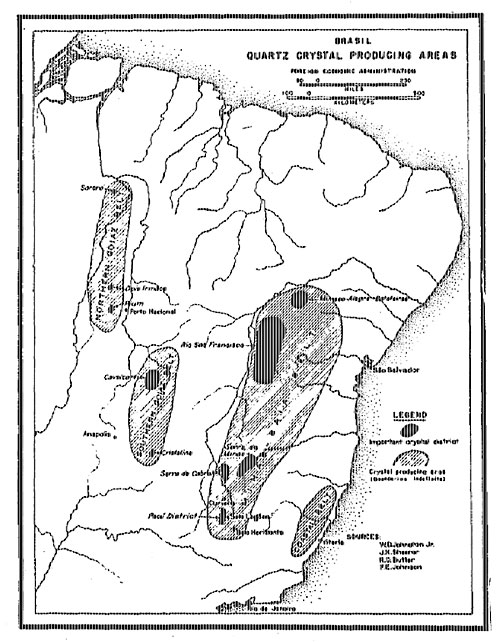
FIG. 1
The other producing region of importance lies in the central part of the state and is virtually continuous with the north central area. Various centers of production have been reported from the southern and southeastern parts of the state, for example Conquista, from which excellent quartz has been obtained. In general the districts in Baia are situated east of the Rio Sao Francisco. Information is extremely scanty regarding the area between the producing areas in Baia and those to the south in Minas Gerais. This region is most inaccessible and may contain important deposits of crystal not yet developed.
Espirito Santo
Numerous small deposits occur in the central part of the state near Vitoria and south of the Rio Doce.
Summary
The regions in Brazil which produce quartz lie in four belts or zones which trend north to northeast in direction as shown in Fig. 1. These belts are: (1) Northern Goiaz – extending for at least 600 kilometers in the northwestern part of the state, west of the Rio Tocantins; (2) Southern Goiaz – extending from the vicinity of Cristalina, Goiaz, northwards along the Goiaz-Minas and Goiaz-Baia border for 500 kilometers with ultimate northern extremity not known; (3) Minas-Baia – extending some 1200 kilometers from Pitangui and Sete Lagôas in Minas Gerais to the vicinity of Sento Se and Joazeiro on the Rio Sao Francisco in Baia; and (4) Coastal – a belt some 300 kilometers in length, including the deposits in Espirito Santo, and those near Aimores, Minas Gerais, at the northern end of the belt. The northern Goiaz zone continues into the adjacent state of Para.
TYPES OF GEOLOGIC QUARTZ OCCURRENCES IN BRAZIL
For convenience of description the Brazilian quartz deposits may be classified into the following types: -
1. Veins and composite lodes
2. Pipes and pockets
3. Blanket deposits
4. Pegmatites
5. Eluvial and alluvial deposits
Deposits of the first three classes mentioned are gradational one to the other. The striking feature of all the deposits is the extremely small proportion of usable crystal in relation to the total quartz. Enormous quantities of milky bull quartz are mined to produce a few kilograms of usable clear crystal. The production comes from hundreds of mines or diggings, very few of which involve underground mining. It is estimated that during the war period there have been no more than six to twelve mines in Brazil in which there has been production of one ton a month for any length of time. Most diggings produce less than 500 pounds per month and many only 50 or less.
Veins and Composite Lodes
Veins and composite lodes yielding commercial quartz are a particularly important type of deposit in the southern part of the Minas-Baia belt. Wall rocks are commonly shale or shale and granite. In other parts of Brazil veins occur in quartzite or sandstone although in these rocks the yield from accompanying bedded replacements, pipes or pockets is the more important.
In the shale near Sete Lagôas in Minas Gerais lodes are fairly persistent along their strike, although in most instances individual shoots or lenses within the veins are not so persistent. The quartz commonly forms conformable bedded deposits in the walls of the vein proper. Because of the varying nature of the crystal occurrences in the walls as well as the variation in width of the lode or vein system, mining widths may show a wide range in any one deposit.
Veins, lodes and their accompanying bedded deposits contain milky bull quartz, clay, manganese and iron oxides, and remnants of country rock. Clear crystal occurs in groups or individuals embedded in the bull quartz or in places in vugs usually nearly filled with material. The clear quartz appears to have formed at a later stage than the bull quartz. Manganese oxide is more abundant in the vicinity of crystal and usually can be considered as an indicator. This association does not assume genetic significance as the time of formation of the crystal and the oxide could have differed greatly.
The best example of a lode in shale is furnished by the Guachi mine near Sete Lagôas (Fig. 2). The vein system has an approximate north-south strike and moderate westerly dip averaging about 60 degrees. Mining has occurred along a strike length of 400 meters and to a depth of some 25 meters below the original surface. The wall rock is weathered shale, yellow in color, lying immediately below a red clay capping which contained some crystal. The system is composed of a series of lenses which pinch out both vertically and horizontally. Greatest mining width reached was a few meters, but horses of country rock occupied much of the cross section. The distribution of values was erratic. The workings at the Guachi mine have now been abandoned because with depth the yield of crystals became uneconomic.
An excellent example of a vein system occurring along a shale-granite contact is afforded by the Onca Mine, also in the Sete Lagôas District. This has been one of the most productive mines with a steady production of one to two tons of mine clean quartz per month. Fig. 3 illustrates the main vein workings, and Fig. 4 represents a geologic cross section of the deposit. The strike length exposed on the mine workings is 500 meters. The workings reach a depth of 30 meters beneath the original surface. The vein strikes approximately north-south and dips to the west at moderate angles ranging from 45 degrees to 65 degrees. The rock on the east (footwall) side of the vein is weathered granite, on the west (hanging wall) side is weathered shale. The lode is composed of a system of quartz stringers, veins, and lenses occupying a position in the shale adjacent to the granite. Horses of shale are common. Along the contact and decreasing away from it into the hanging wall, the shale is somewhat folded and distorted with extremely variable dips. It appears in general to have moderate dips, slightly flatter than the contact dip near the contact, and to become flatter to the west. Quartz also occurs along the bedding planes in the crumpled shales of the hanging wall (Fig. 5).
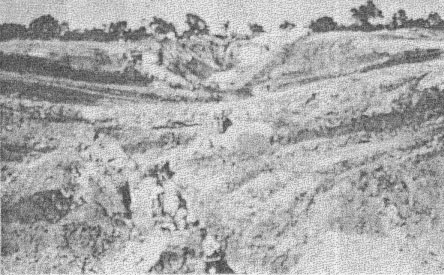
FIG. 2. Looking south along the strike of the vein system at the Guachi mine, near Sete Lagôas, Minas Gerais. Mining of nearly vertical vein by hand methods in foreground. Red overburden has been stripped off and mining will advance to center of picture. Old workings are in background pit on same vein zone although individual veins pinch out along the strike.

FIG. 3. Looking south along strike of the vein zone, Onca Mine, Sete Lagôas, Minas Gerais. Weathered shale to the right is the hanging wall. Footwall of granite is in shadow to the left.
Due to the structure of the lode and the varying quantity of hanging wall quartz, mining widths vary greatly, ranging up to 20 meters in places. It is held that the granite has intruded the shale, or the shale has been faulted against the granite, or the shale was deposited adjacent to an eroded granite ridge. H. K. Shearer who has done the most work in the region advocates the depositional contact.
The important deposits near Pium, Goiaz, as described by H. K. Shearer9 are best classed as veins. Wall rocks are schists of sedimentary derivation and intercalated quartzite. Weathering has rendered the formations soft. The quartz occurs in irregular veins and lenses, transecting the schist and quartzite. Individual crystals of bull quartz attained enormous sizes. Shearer mentions one 2.5 meters in length and 1.5 meters in diameter. Clear crystal of commercial value represents only a fraction of the material which is mined.
Pipes and Pockets
Pipes or irregular conical or funnel-shaped masses and pockets of quartz occur in Baia, southeastern Goiaz, Minas Gerais and perhaps else where. Wall rocks are quartzite or sandstone. The sizes of the pipes and pockets show great variations, and accompanying veins, pods, bedded replacements, and lenses are common. Some deposits which are classed with pipes are more in the nature of elongated pods. There is little essential difference between a pipe, pocket or the common blanket deposit in quartzite or sandstone. Some of the deposits in the vicinity of Cristalina, Goiaz, include all variations. Zones of small pockets, veinlets and replacement masses lie in sandstone along a north trending structural axis. The deposits in the Cristalina district have been described by W. D. Johnston Jr.10
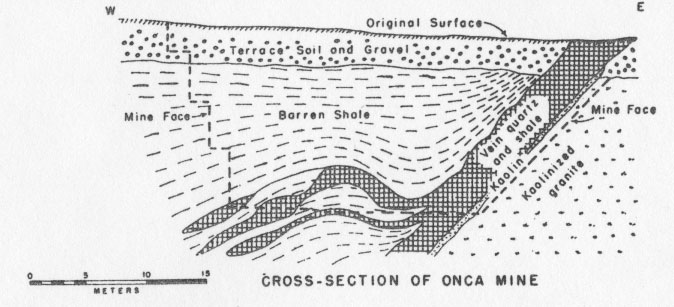
FIG. 4. Cross section of Onca Mine. After H. K. Shearer.
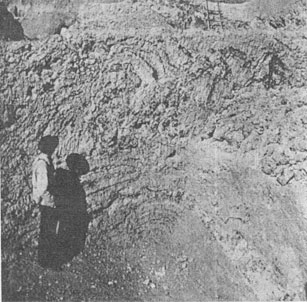
FIG. 5. Official U. S. Navy Photograph. Veins in folded shale of the footwall, Onca Mine, Sete Lagôas, Minas Gerais. Veins contain quartz and manganese oxide. Similar veins, somewhat larger than most of those in the picture are the source of much good crystal.
Perhaps the best example of a pipe-like deposit is afforded by the Alegre mine some 20 kilometers south of Mimoso, Baia. The country rock is compact, fine-grained quartzite. According to F. D. Hanson11 the pipelike mass of quartz is localized at the intersection of two fairly prominent groups of closely spaced joints or fissures of small displacement. The bulk of the material in the pipe is coarse milky bull quartz containing some comb quartz and well-formed crystals. The pipe is approximately 10 meters by 15 meters in horizontal dimensions and has been mined to a depth of 15 meters. The walls are extremely irregular and pockets, tongues and masses of quartz protrude from the margins into the surrounding rock. Clear crystals occur in irregularly shaped pockets within the bull quartz throughout the volume which has been opened. There is no clue to the structural distribution of the valuable material. Pockets are filled in varying degrees with clear crystal which is well terminated. Replacement of the country rock was the dominant process although the silica may have been provided from the surrounding quartzite.
An interesting and common feature of the crystal from the Alegre Mine is the presence of phantoms of manganese oxides in many of the otherwise clear crystals. Except for this defect, the crystal is reported to be of good quality.
Blanket Deposits11a
Blanket replacement deposits are well developed at Mimoso and elsewhere in Baia, at many places in Minas Gerais, and in Goiaz. It is common for this type of deposit to be associated with veins in shale sandstone, or quartzite, and with pipes, pods, and associated forms in sandstones and quartzites. The deposit at Mimoso is not associated with accessory types and furnishes a spectacular example of blanket deposit from which there has been important production.
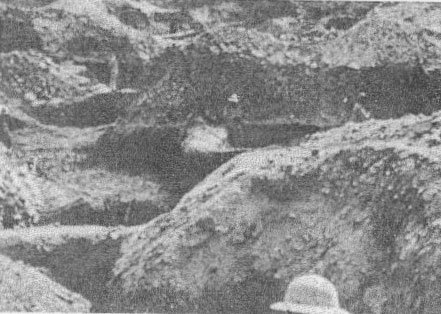
FIG. 6. Pits in shale, some of which extend down to lower bull quartz horizon, Mimoso, Baia. Walls of broken rock between pits are shored up with boulders of bull quartz which have been mined in search for crystal. Stripping has exposed upper quartz horizon in left center of the photograph. Man in center stands on top of upper quartz horizon.
Mimoso lies about 200 kilometers west of Bomfim, Baia, in the midst of a dissected plateau with sandstone and quartzite exposed at the surface. Shale underlying the sandstone is exposed in the valleys. A broad flat anticlinal dome with its axis trending east-west shows an indefinite terrace on its southern flank. Dips range from 4 degrees to 7 degrees and the terrace is essentially horizontal. Three beds of replacement quartz occupy closely spaced positions in the shale country rock (Figs. 6, 7 and 8). The horizontal continuity of these beds has not been entirely established. The middle bed is relatively insignificant, thin, and restricted in its occurrence and will not be discussed further. All the beds contain residual masses of shale. Here and there erosion has exposed the beds but for the most part they are covered by partly weathered shale. The upper bed probably underlies an area of about 2.5 square kilometers on the south flank of the dome. It ranges in thickness from less than one to two meters. The lower bed underlies a known area of about 2 square kilometers more or less coextensive with the terrace but extending beyond its limits, particularly to the west and to the south down the dip. It ranges in thickness from about 1 to 4 meters. The average separation between the two beds is about 8 meters. Each bed has produced large quantities of crystal.
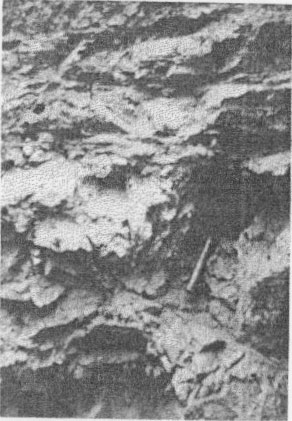
FIG. 7. Blanket deposit. Mimoso, Baia. Coarse-grained bull quartz and pockets from which commercial crystal has been removed.

FIG. 8. Cross section of the important blanket deposit, Mimoso, Baia. After J. C. Schell. Looking northeast. Horizontal distance represented is 350 meters. Vertical scale exaggerated.
The best production from the upper bed was realized from the central part of the area along a belt parallel to the structural terrace and overlapping its extent towards the crest of the dome. Many parts of the lower bed have been prospected up to this time but the best production has been obtained from a small zone of about 10,000 square meters area, lying in the structural terrace. Small abrupt folds striking northeast-southwest occur in the vicinity of the best crystal (Fig. 9), and tiny quartz-filled joints are present in the shale beds. Prospecting along the trends of folds or groups of joints has been fairly successful. In the outlying part of the district active prospecting along these features has, however, not yet disclosed commercial crystal.
Manganese and iron oxides and clay are the only visible minerals accompanying the quartz. The lower bed, for example, consists of massive bull quartz of varying crystallinity, some of the crystals being fairly well-formed. At planes thought to be localized or at least related to the structural features in the shales, manganese staining becomes more prominent and continued work at times leads to a pocket of crystal. The pockets range from a few centimeters in size to several meters and are filled to varying degrees with well-formed crystal not all of which, however, is a commercial product. The commercial crystal characteristically contains “blue needles.” Pockets may be within the massive bull quartz or make out into the roof or bottom. There does not appear to be a favored vertical position within the quartz bed for the development of crystal. Enormous quantities of material have been mined at Mimoso. Much of the work, however, has been in an attempt to reach the crystal zone itself so that the ratio of earth moved to crystal produced has depended upon the depth of the bed.
At the Rosilho mine, southeast of Mimoso, a steeply dipping vein flattens near the surface to form a blanket of small extent in the country rock which is sandstone. Adjacent to the bull quartz blanket the sandstone is noticeably silicified. This occurrence provides a clear example of wall rock alteration adjacent to a quartz deposit. In general, however, observation of the effects of wall rock alteration is difficult due to the extensive weathering.
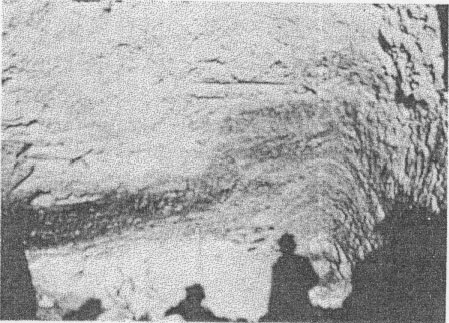
FIG. 9. Small fold in shale. Mimoso, Baia. These folds appear to be related to concentration of crystal in the bull quartz exposed in the bottom of the pit.
Pegmatites
True pegmatites have not contributed appreciably to the quartz production of Brazil. It is suspected that the pegmatite belt of eastern Minas Gerais may contain some crystal, but production from true pegmatites appears to be insignificant. Deposits from Teofilo Ottoni, Minas Gerais, are reported to be of pegmatite type. It is possible that the crystal from the swamp-covered alluvial deposits of Espirito Santo is of pegmatitic derivation as suggested by Knouse.
12 Veins or masses with feldspar could be classed as pegmatitic or possibly as deposits allied to the pegmatites. Two representatives of this type are known: one near Conquista, Baia, the other near Oliveira dos Brejinhos, Baia. The crystal from Conquista is of excellent quality and although material from Oliveira dos Brejinhos is supposed to be good, no first hand data are available.
Oliveira dos Brejinhos lies about 60 kilometers southeast of Jardinopolis which is on the Rio Sao Francisco. The quartz mine is a few kilometers west of the town. According to F. L. Knouse,
13 a formation composed mainly of fine-grained quartzite strikes north-south and dips 60 degrees west. from a ridge west of Oliveira dos Brejinhos. Two sill-like masses of quartz and kaolinized feldspar constitute the deposit. One is about 4 meters thick, the other about 2, and they are separated by about 7 meters of country rock quartzite. About 80% of the bodies consists of a quartz core; kaolinized feldspar with tourmaline needles lies along both the foot and hanging walls. Commercial crystal occurs throughout the quartz but particularly so in the kaolinized footwall.
The deposit near Conquista, Baia was examined by D. de C. Smythe.
14 Vertical veins a few centimeters in thickness cut sandstone and gneiss exposed along the slopes of a low hill. The veins have a central zone of quartz and margins of red feldspar. Crystals are large and some of them contain usable portions.
Eluvial and Alluvial Deposits
Eluvial deposits of quartz occur throughout the crystal-producing region of Brazil. They grade on the one hand into alluvial deposits and on the other into primary material in place. The surface zone at Pium may be considered as eluvial, and there are numerous examples in Minas Gerais (Fig. 10). Crystal is mined from many places where eluvial and alluvial processes and primary deposition are all important and it is difficult to diagnose the actual relations. Float at the surface has been the common indicator of underlying deposits (Fig. 11). Quartz from eluvial deposits may show a considerable degree of rounding. It is probable that while some of these deposits may be the eroded roots of primary deposits, others may overlie primary deposits and represent erosion of a considerable thickness of overlying material concentrated by gravity without lateral movement.
Undoubtedly alluvial deposits occur throughout the crystal-producing region, but so far as is known are best represented in central Minas Gerais and Espirito Santo. Present streams occasionally yield commercial stones as a by-product of diamond placering. In general alluvial deposits lie buried beneath clay, particularly red clay, or beneath swampy ground as in Espirito Santo.
15 They are characterized by small-to-medium-sized stones, the commercial ones being of good quality though usually somewhat rounded (Rollados), contained in a relatively thin bed of clay. In places several beds occur separated by a meter or so of noncrystal-bearing clay, sand or gravel.
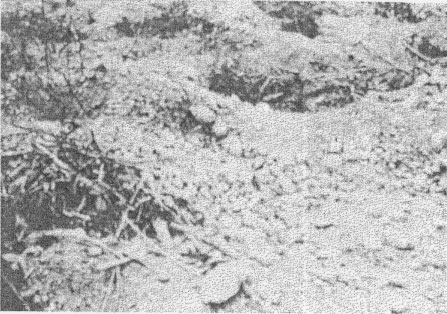
FIG. 10. Eluvial deposit, northwest of Sete Lagôas, Minas Gerais. Crystals are picked from the dirt which is broken down by picks and shovels. A carry-all removes the material to the dump.
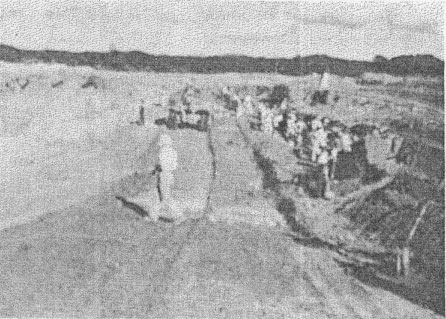
FIG. 11. Prospect pits in residual weathered rock representative of the hundreds of such pits near Sete Lagôas, Minas Gerais. The bedrock in this region is red shale. Rock fragments are bull quartz.
The Gameleira mine furnishes an excellent example of an alluvial deposit. It lies about 70 kilometers north of Curvelo, Minas Gerais. A bed of crystal-bearing yellow clay with maximum thickness of one meter underlies a varying quantity of red clay along the flanks of a very gently sloping hill. The thickness of the red clay overburden ranges from two to six meters.
SUMMARY OF MINERALOGY OF BRAZILIAN DEPOSITS
The mineralogy of the crystal deposits in bedrock is extremely simple. Quartz crystals are not produced in quantity from the same veins which produce other minerals. A black manganese oxide mineral frequently occurs in the crystal-bearing sections of the quartz veins and chlorite and limonitic stain are common. Several other minerals are reported, such as tourmaline, anatase, rutile, pyrite, an amphibole and clay minerals. A crystal supposed to have come from one of the mines in quartzite in Baia contains a small fairly perfect diamond included in the cap. Inclusions of pyrite are very rare. Quartz said to have originated near Xique-Xique, Baia, is yellow in color and contains fluid inclusions, hydrogen sulphide being given off when scratched. Shearer
16 reports a minute quantity of associated pyrite and arsenopyrite from deposits near Pium, Goiaz. Chlorite is commonly included in the crystals from the Pedra Verde mine in the Mimoso district of northern Baia. More thorough mineralogical study will undoubtedly add to the list of associated minerals. These associated minerals are, however, rare except for the oxides of manganese and iron, clay minerals and chlorite, so rare that specimens of them from crystal mines are unusual.
The crystals occur in vugs or pockets in the milky vein quartz. The ratio of milky or cloudy bull quartz to clear crystal varies but has been estimated as lying between 10,000 to 1 and 1000 to 1.
Quartz crystals occur in the veins in all sizes from the most minute to those famous crystals which weigh over five tons each. Some idea of the size distribution may be had from the following figures calculated from records of the weight classification of material purchased by the U. S. Government over a part of the war period.
The statistics show the greater rarity of the heavier (larger) crystals but also indicate that a surprising percentage fall in the 300-700 gram (approximately ½ lb.-1½ lbs.) category. It should be pointed out that there are certain limitations on the data since the figures were not compiled for the purpose to which they are being put in this paper although they nevertheless serve as a basis for a quantitative estimate. The figures represent size distribution of crystals in the 200-10,000 gram weight class which have been prepared for market and sold to the U. S. Government. Actually one end of many of the crystals may have been trimmed to remove cloudy areas; therefore, the figures indicate smaller-sized crystals than would actually be the case if the data related to newly mined untrimmed material. To an important degree material under 200 grams also finds a market and is very plentiful. It may be estimated that there are at least twice as many crystals of 100-200 gram weight class as all the larger sizes.
QUARTZ CRYSTALS PURCHASED FOR NATIONAL STOCKPILE DURING PART OF THE WAR PERIOD*
Crystal Weight Group
Weight in Grams
Percentage of the Total Number of
Crystals Which Were in Each
Weight Group
200- 300
55.5
300- 500
29.5
500- 700
10.4
700- 1,000
2.1
1,000- 2,000
1.8
2,000- 3,000
0.5
3,000- 4,000
0.2
4,000- 5,000
<0.1
5,000- 7,000
<0.1
7,000-10,000
<0.1
* Data based on over l2 million crystals.
It is noteworthy that little of the clear quartz on the market is without a recognizable crystal face. Many of those unfaced crystals sold are fragments of larger crystals which did occur with natural faces present. From figures available it appears that the percentage of material in the 200 gram to 10,000 gram weight range which contains no recognizable face is from 5 to 20% of the total. Examination of the mines also points to the same conclusion. Anhedral quartz in the veins is almost entirely milky; translucent patches are rare or absent. While this might be expected, this contrasts with the condition of the massive quartz in some of the North Carolina-Virginia quartz veins in which translucent but not clear areas of vein quartz are sometimes seen.
I am bidding on this elastial
up for auction tomorrow!









Comments (14)
I’m using my blog just to remember, too.
And I’m still waiting for you to find the crystal that calls my name.
Let me know, ‘k?
I love you…GFW
I was just gonna skip by it all, but having the addiction to maps, and affection for Brasil, that I do, I got stuck here a while. :sunny:
BE blessed!
Steve :spinning:
Very interesting…thanks for teaching me so much about crystals:sunny:
what are the measurements of that elastial??? gosh… good luck with winning the bid. i have one… i posted in August i believe. it is such a great crystal. i sometimes snuggle with it or let it sleep with me. i just love quartz. those are some great pics you posted with this blog too.
i will post it
:sunny:
Ho-lee Homma-da!!! :spinning: No way would I read all of that but the pics are awesome as usual. Hope you get the elastial. It looks huge.
Hope you get the elastial. It looks huge.
groovy
Ours is still pretteir. seen that elestial. that shipping price is kinna scary. cool rock tho.
:coolman: my stones are from Brazil the interesting ones :coolman: nice are you trying to take over the world ? lol love beck
Thats a lot to reference… my oldest is a geologist…..and has rocks and crystals all over her house…. if I can catch up to her I think she might like your compilation of information and my alliteration if I use the same term when I email her:)
this is very interesting…you are so scholar about crystal..you found nice world indeed…

thanks your comment…not only me , anyone conciderate about 9.11 and after truble in middle east were influenced by thire privert quarrel..It’s sad 3,000 USA troop died already..and ofcource 3,000 people who died at WTC…if attack to Iran , how involeve to citizen more…as they say ” enemy “ and inside, both ,too…
I especially like that picture of the blue kyanite, and the rutilated quartz. Woooo-Hoooo!
Hello Web Admin, I noticed that your On-Page SEO is is missing a few factors, for one you do not use all three H tags in your post, also I notice that you are not using bold or italics properly in your SEO optimization. On-Page SEO means more now than ever since the new Google update: Panda. No longer are backlinks and simply pinging or sending out a RSS feed the key to getting Google PageRank or Alexa Rankings, You now NEED On-Page SEO. So what is good On-Page SEO?First your keyword must appear in the title.Then it must appear in the URL.You have to optimize your keyword and make sure that it has a nice keyword density of 3-5% in your article with relevant LSI (Latent Semantic Indexing). Then you should spread all H1,H2,H3 tags in your article.Your Keyword should appear in your first paragraph and in the last sentence of the page. You should have relevant usage of Bold and italics of your keyword.There should be one internal link to a page on your blog and you should have one image with an alt tag that has your keyword….wait there’s even more Now what if i told you there was a simple WordPress plugin that does all the On-Page SEO, and automatically for you? That’s right AUTOMATICALLY, just watch this 4minute video for more information at. Seo Plugin